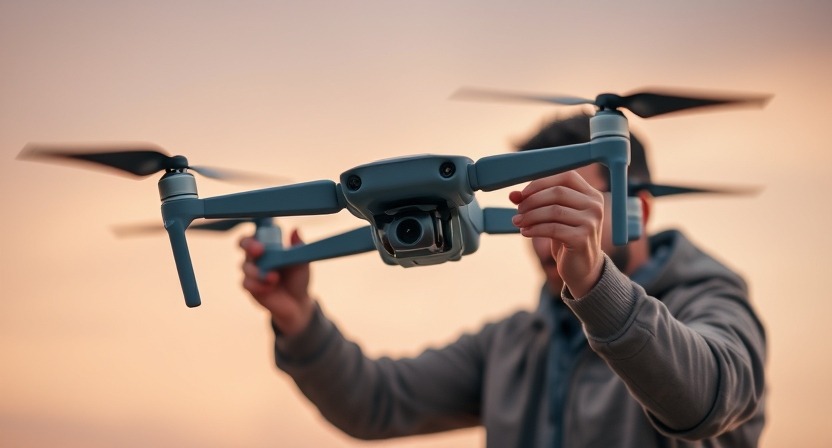In the past, capturing breathtaking aerial shots was something only professional filmmakers or wealthy photographers could afford. Expensive helicopters, complicated gear, and special permits made it an exclusive art. But today, drones have completely transformed this landscape. These flying marvels have made aerial photography and videography not just affordable but accessible to everyone—from hobbyists to seasoned professionals.
Let’s dive into how drones are reshaping photography and the endless creative opportunities they offer.
Why Drones Are a Game-Changer for Photography
Drones are more than just devices—they’re gateways to entirely new perspectives. They allow photographers and videographers to go where no handheld camera can, capturing dramatic angles, expansive views, and dynamic shots that add depth and emotion to visual storytelling.
Here’s what makes drones so revolutionary:
1. Accessibility: High-quality drones are now available at various price points, making them suitable for beginners and experts alike.
2. Ease of Use: Modern drones come with features like GPS, auto-stabilization, and smart flight modes, making them user-friendly.
3. Versatility: Drones are perfect for different kinds of photography, from sweeping landscapes to artistic urban shots.
Aerial Photography: A New Way to See the World
Drones have opened up endless possibilities for creative expression. Let’s explore some of the most popular applications of aerial photography:
1. Stunning Landscape Shots
From majestic mountain ranges to sprawling beaches, drones capture the grandeur of nature in ways that ground photography simply can’t. The ability to shoot from above allows photographers to showcase patterns, textures, and scale, creating mesmerizing images.
- Imagine flying a drone over a dense forest in autumn—vivid red, orange, and yellow leaves forming a mesmerizing mosaic.
- Showcasing a bird’s-eye perspective of winding rivers weaving through serene valleys..
2. Urban Views and Architecture
Cities take on a completely different personality when seen from above. Aerial shots highlight the symmetry of streets, the artistry of skyscrapers, and the vibrant energy of urban life.
- Drones can zoom out to capture entire cityscapes or zoom in for detailed shots of unique architectural structures.
- Even rooftop gardens, bustling marketplaces, and urban murals gain new life when photographed from the air.
3. Creative Wedding and Event Photography
Wedding and event photographers are embracing drones to add a touch of magic to their work.
- Picture a couple sharing their first dance under a twilight sky, captured in one sweeping drone shot.
- Drones also excel at group shots, offering creative ways to photograph large gatherings from dramatic angles.
Beyond Photography: Other Applications of Drones
The potential of drones isn’t limited to photography. They’re becoming essential tools in a wide range of fields:
1. Cinematography: Drones make it easier to film action sequences, sweeping panoramas, and chase scenes in movies and advertisements.
2. Real Estate: Realtors use drones to showcase properties, providing potential buyers with virtual tours of homes and neighborhoods.
3. Environmental Monitoring: Conservationists and researchers use drones to study wildlife, monitor deforestation, and even fight poaching.
4. Construction and Engineering: Drones are used to inspect sites, map terrain, and track project progress.
Your First Steps into Drone Photography
If you’re new to drones, getting started is easier than you might think. Here’s a step-by-step guide:
1. Choose the Right Drone: Look for a model that fits your budget and skill level. Popular beginner-friendly drones include DJI Mini 3 and Autel EVO Nano+.
2. Learn the Basics: Practice flying your drone in open spaces before attempting complex maneuvers or capturing professional shots.
3. Understand the Rules: Many countries have regulations for drone usage, especially in public or urban spaces. Make sure to follow local laws and obtain permits if needed.
4. Experiment with Angles: Don’t be afraid to get creative—experiment with different heights, tilts, and camera settings to find your unique style.
Tips for Taking Perfect Aerial Shots
Achieving breathtaking drone shots isn’t just about the gear—it’s also about skill and creativity. Here are a few tips to take your photography to the next level:
- Shoot During Golden Hours: Early mornings and evenings offer the best natural lighting for dramatic shadows and warm tones.
- Focus on Composition: Use leading lines, symmetry, and the rule of thirds to create visually striking images.
- Add Movement: Capture dynamic shots by following moving objects, like cars on a highway or waves crashing against the shore.
- Edit Your Photos: Post-processing tools like Lightroom or Photoshop can enhance your aerial shots, bringing out their full potential.
The Future of Aerial Photography
As drones continue to evolve, so do their capabilities. Future advancements might include better obstacle detection, longer battery life, and enhanced AI features for autonomous flight. These innovations will make it even easier for photographers and videographers to push creative boundaries.
Moreover, drones are becoming increasingly integrated into industries like marketing, journalism, and environmental studies. With their versatility and potential, they’re here to stay.
Final Thoughts
Drone photography is more than just a trend—it’s a revolution in how we capture and share the beauty of our world. Whether you’re looking to take stunning vacation photos, create cinematic masterpieces, or explore new creative hobbies, drones are the perfect gateway.
With the sky as your canvas, the possibilities are endless. So, why not take your photography to new heights?







